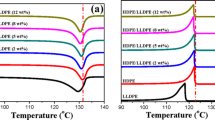Abstract
The polypropylene (PP) microporous membrane is prepared by only hot stretching of annealed PP film under different stretching rate and temperature. The structure and properties are compared with those by cold and hot stretching. The results show that apparent connecting bridges are observed on the surface of final microporous membrane only by hot stretching. With increasing stretching rate and decreasing stretching temperature, the pore size decreases and the air permeability becomes worse. The membrane only by hot stretching under 50 mm/min shows better lamellae separation, whereas under 10 mm/min the membrane gives lowest Gurley value. Compared with cold and hot stretching under the same stretching rate and whole stretching ratio, the membrane stretched only by hot stretching shows longer connecting bridges length, higher porosity and lower Gurley value. During only hot stretching, first the tie chains in the amorphous region are stretched. Then the combination of crystalline main lamellae and crystalline part formed during annealing is stretched and converted to connecting bridges. Through the control of stretching temperature and rate, PP microporous membrane with better permeability property can be obtained by only hot stretching, where room-temperature stretching is not needed. The obtained membrane can be used in Li-ion battery field as a separator, where the air permeability is an important technical parameter to characterize the Li-ion penetration ability through the separator.









Similar content being viewed by others
References
Sadeghi F (2007) Developing of microporous polypropylene by stretching. PhD Thesis, Ecole Polytechnique de Montreal, Canada
Johnson MB (2000) Investigations of the processing-structure–property relationship of selected semi-crystalline polymers. PhD Thesis, Virginia Polytechnic Institute and State University, US
Tabatabaei SH, Ajji A (2011) Effect of initial crystalline morphology on properties of polypropylene cast films. J Plast Film Sheet 27(3):223–233
Yu TH, Wilkes GL (1996) Orientation determination and morphological study of high density polyethylene (HDPE) extruded tubular films: effect of processing variables and molecular weight distribution. Polymer 37(21):4675–4687
Sadeghi F, Ajji A, Carreau PJ (2005) Study of polypropylene morphology to obtain porous membranes by stretching. Proc SPE ANTEC 1:163–167
Sadeghi F, Ajji A, Carreau PJ (2007) Analysis of microporous membranes obtained from polypropylene films by stretching. J Membr Sci 292(1–2):62–71
Sadeghi F, Ajji A, Carreau PJ (2005) Study of polypropylene morphology obtained from blown and cast film processes: initial morphology requirement for making porous membrane by stretching. J Plast Film Sheet 21(3):199–216
Sadeghi F, Ajji A, Carreau PJ (2007) Analysis of row nucleated lamellar morphology of polypropylene obtained from the cast film process: effect of melt rheology and process conditions. Polym Eng Sci 47(7):1170–1178
Tabatabaei SH, Carreau PJ, Ajji A (2008) Microporous membranes obtained from polypropylene blend films by stretching. J Membr Sci 325(2):772–782
Tabatabaei SH, Carreau PJ, Ajji A (2009) Effect of processing on the crystalline orientation, morphology and mechanical properties of polypropylene cast films and microporous membrane formation. Polymer 50:4228–4240
Tabatabaei SH, Carreau PJ, Ajji A (2009) Microporous membranes obtained from PP/HDPE multilayer films by stretching. J Membr Sci 345(1–2):148–159
Sadeghi F, Ajji A, Carreau PJ (2008) Microporous membranes obtained from polypropylene blends with superior permeability properties. J Polym Sci Polym Phys 46(2):148–157
Kim J, Kim SS, Park M et al (2008) Effects of precursor properties on the preparation of polyethylene hollow fiber membranes by stretching. J Membr Sci 318(1–2):201–209
Lei CH, Wu SQ, Xu RJ, Peng XL, Shi WQ, Hu B (2013) Influence of low molecular weight tail of polypropylene resin on the pore structure by room-temperature stretching. Polym Eng Sci. doi:10.1002/pen.23527
Lei CH, Huang WL, Xu RJ, Xu YQ (2012) The correlation between the lower temperature melting plateau endotherm and the stretching-induced pore formation in annealed polypropylene films. J Plast Film Sheet 28:151–164
Lei CH, Wu SQ, Xu RJ, Xu YQ, Peng XL (2013) A study of plastic plateau disappearance in stress–strain curve of annealed polypropylene films during stretching. Adv Mater Res Intern J 2(2):111–118
Lei CH, Wu SQ, Xu RJ, Cai Q, Hu B, Peng XL, Shi WQ (2013) Formation of stable crystalline connecting bridges during hot stretching of polypropylene hard elastomer film. Polym Bull 70(4):1353–1366
Degroot JA, Doughty AT, Stewart KB et al (1994) Effects of cast film fabrication variables on structure development and key stretch film properties. J Appl Polym Sci 52(3):365–376
Nogales A, Hsiao BS, Somani RH et al (2001) Shear-induced crystallization of isotactic polypropylene with different molecular weight distribution: in situ small- and wide-angle X-ray scattering studies. Polymer 42(12):5247–5256
Taskier H (1982) Hydrophilic polymer coated microporous membranes capable of use as a battery separator. US Patent 4359510
Kamei E, Ashitaka H, Takahashi T (1992) Method of producing microporous film. US Patent 5173235
Kurauchi H, Akazawa T, Kawabata A (1995) Porous multi-layer film. European Patent 0682376 A1
Lei CH, Li SL, Huang WL (2010) Application of capillary flow porometry in the characterization of pore size distribution for microporous separator. J Guangdong Univ Technol 27:54–56
Zuo F, Keum JK, Chen X, Hsiao BS, Chen H, Lai SY, Wevers R, Li J (2007) The role of interlamellar chain entanglement in deformation-induced structure changes during uniaxial stretching of isotactic polypropylene. Polymer 48:6867–6880
Acknowledgments
The authors would like to thank National Science Foundation of China under Grant No. 51003017 for financial support. They also want to thank Shenzhen Senior Materials Company, Ltd., for generously supplying raw materials.
Author information
Authors and Affiliations
Corresponding author
Rights and permissions
About this article
Cite this article
Wu, S., Lei, C., Cai, Q. et al. Study of structure and properties of polypropylene microporous membrane by hot stretching. Polym. Bull. 71, 2205–2217 (2014). https://doi.org/10.1007/s00289-014-1182-6
Received:
Revised:
Accepted:
Published:
Issue Date:
DOI: https://doi.org/10.1007/s00289-014-1182-6




